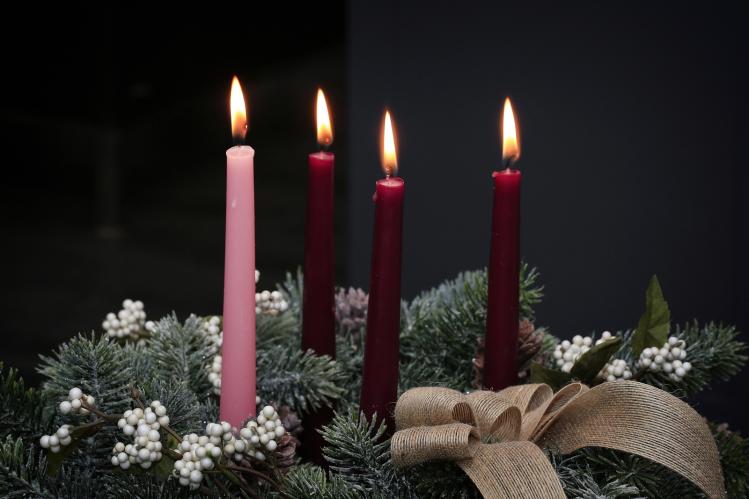
The first reading for the First Sunday of Advent this year was Isaiah 2:1–5. It speaks of waiting for “days to come” when the nations “shall beat their swords into plowshares and their spears into pruning hooks,” and they will not “train for war again.”
Like Isaiah, we await a baby in a crib, the birth of the Messiah. And after that Messiah’s Ascension into heaven, Christians again wait for his final coming. This is the richness and beauty of Advent: we’re both waiting for Christmas and preparing for the eschaton (from the Greek for “the end”). By the Fourth Sunday of Advent, the readings will have shifted to focus on the virgin birth (Isaiah 7:10–14) and the Nativity (Matthew 1:18–24). But much of the Advent liturgy, including the Liturgy of the Hours, trains our minds and hearts on waiting for the fullness of Christ’s presence among his people at the end of time.
We aren’t terribly used to waiting any more, at least patiently. We are especially bad at expectant waiting: waiting that is patient, intentional, and eager. Advent is a time to renew this eagerness of waiting for the coming of the Messiah.
Much of the waiting we do experience we think of in the negative—a lack of something that we want. We wait for a bus that isn’t here yet, an apology we think someone owes us. But these things may never materialize: the bus may have broken down, the apology might not be forthcoming. This negative waiting is essentially different from the expectant waiting of Advent, since the virtue of faith assures us that the long-awaited Messiah has already appeared and sent the Holy Spirit as “the pledge of our inheritance” (Ephesians 1:14). Even our waiting for Christ’s return is not a lack, for the “fullness of the one who fills all things in every way” (Ephesians 4:23) is already present in the mystery of Christ’s kingdom, the church. What we truly await is the final revealing, “in power and great glory,” of what is already present in mystery (CCC §671). This pregnant tension between “already” and “not yet” transforms negative waiting into expectant waiting, uncertainty into hope. Rather than the anxiety that too often springs from uncertainty, Advent calls us instead to “rejoice in hope” (Romans 12:12).
What are we to do in this time of Advent, then? What can make our waiting eager and expectant? If we want guidance on waiting for the final fulfillment of our hope, we might turn to the church’s monastic tradition. Monks train their attention, making their lives a sign that “the world and its enticements are passing away” (1 John 2:17). The practices of monastic life train the monk (or anyone who adopts them) to “be attentive...until day dawns and the morning star rises in [their] hearts” (2 Peter 1:19).
The monks have one perennial suggestion for how to wait: to ruminate or “chew over” the words of the Scriptures. We do this to internalize them, to taste their full savor, and to enjoy the richness made from taking the Books of the Old Covenant alongside the New, from experiencing them as integral to one another. The monks never grew weary of tasting how rich the associations in the Scriptures were, and Advent is a feast for those with the patience to see the connections as the liturgy of this season unfolds.
In Advent, the Christian assembly takes on the words of the prophets awaiting a better world, the New Zion. We celebrate the Lord as shoot, bud, and root of Jesse; the great King who will save the Daughters of Jerusalem; dew on the fleece of Gideon; Shepherd of Israel; the Prophet of Deuteronomy; the Lamb of God from Exodus; Vinedresser; Prince of Peace. In the ancient O Antiphons that ramp up the final days of Advent, he is the Wisdom of God, the presence in the burning bush, Key of David, Radiant Dawn, Keystone, the Son of the Virgin called Emmanuel, and finally, on Christmas Eve, the Radiant Bridegroom coming from the bridal chamber.
What can patient rumination on all these associations bring us? In these scriptural resonances, one note is struck above all: accord. The fertile tension between “already” and “not yet” in which we live calls us to apprehend this accord with an attentive clarity of spiritual vision. In bringing together the Torah, Judges, the wisdom books, and the prophets with the gospels and the letters of the New Covenant, we discern in our expectant waiting the unity of God’s plan, stretching from before creation to the consummation of all things. With this in mind, we can resist the animosity, rancor, and discord of our world and instead attend to the Lord and his gifts of peace, harmony, and unity that can exist among precious diversity. “For in him all the fullness was pleased to dwell, and through him to reconcile all things for him, making peace by the blood of his cross [through him], whether those on earth or those in heaven” (Colossians 1:19–20). Advent reminds us of this reconciliation and peace flowing from the divine fullness and the most holy sacrifice of the cross, precipitated by the Incarnation at Christmas and brought to its own fullness on the great Last Day.


